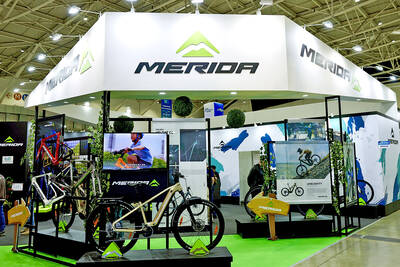It was “Lehman Weekend.” The moment in September 2008 when the 150-year-old investment bank Lehman Brothers Holdings Inc collapsed, precipitating the worst global economic crisis since the 1930s.
After failing to find buyers for the troubled financial giant, which was weighed down by risky debt holdings made up of subprime mortgages, US authorities declined to offer a bailout and allowed the institution to fail.
On Sept. 15, 2008, at 1:45am, Lehman Brothers took the world by surprise when it filed for bankruptcy, leaving more than US$600 billion in debt, as well as 25,000 employees in shock.

Photo: EPA-EFE
It was the biggest bankruptcy in US history. On Wall Street, the Dow Jones plunged 500 points, the largest drop since the attacks of Sept. 11, 2001. Stunned traders streaming out of the building carrying boxes of their belongings became a symbol of the crisis.
Some were caught by surprise, but others, like Lawrence McDonald, a former trader and co-author of a 2009 book on the collapse — A Colossal Failure of Common Sense: The Incredible Inside Story of the Collapse of Lehman Brothers — said that management had long been alerted to the excessive risks it took to increase short-term profits.
The top Lehman leadership, housed on the bank’s 31st floor, “drove us 162 miles an hour ... right into the biggest subprime iceberg ever seen,” he said in 2009.
“It was 24,992 people making money and eight guys losing it,” he said, lamenting that the management “bet the ranch” on toxic assets.
From 2005 to 2007, at the height of the real-estate bubble, when mortgages were given to many homebuyers who could not afford them, and then packaged into securities and sold off, Lehman Brothers bought several mortgage brokerages and posted record profits.
However, in mid-2007, the losses began to build. The knockout punch came nine months later, on March 16, 2008, with the near bankruptcy of another investment bank, Bear Stearns Cos.
Bear Stearns was on the verge of bankruptcy also because of its massive bets on subprime mortgage securities, and was bought for a pittance by JPMorgan Chase & Co, in a sale brokered by the US Federal Reserve. The deal shook markets, which started betting on Lehman’s demise.
The Fed and the US Department of the Treasury tried to find a buyer, negotiating in vain with a South Korean bank, then with Bank of America Corp and Barclays PLC.
However, while the government just a week earlier took over mortgage giants Fannie Mae and Freddie Mac — government-sponsored private enterprises that guarantee more than US$5 trillion in home loans — in the end, officials chose to abandon Lehman.
A few days later, Uncle Sam would rescue insurance giant American International Group Inc (AIG) for US$180 billion, before providing another US$700 billion dollar in a controversial recapitalization plan to prop up banks — the Troubled Asset Relief Program — to try to shore up the teetering financial system.
Authorities found themselves between a rock and a hard place, and have been widely criticized for sacrificing Lehman Brothers, but saving other banks, such as Goldman Sachs Group Inc.
“The thing we get the most criticism for is letting Lehman go down,” said Henry Paulson, who served as secretary of the treasury under US president George W. Bush and was at the helm at the start of the crisis.
“Many people say well they were able to save Bear Stearns, they were able to save AIG, why couldn’t they save Lehman? We answer it and most people don’t believe us,” he told US National Public Radio.
Officials concluded that Lehman was so weak and had so little collateral that a bailout would be simply unworkable.
Timothy Geithner, who led the New York Fed during that time and later became secretary of the Treasury under then-US president Barack Obama, said thatofficials had very few options.
“Lehman was terribly weak even relative to the other weaker institutions in this context. The world was terrifically fragile,” he told NPR. “It was very hard to find someone strong enough in that moment of peril that was going to be capable of taking on the vast bulk of that risk.”
However, others, including Laurence Ball, head of the economics department at Johns Hopkins University, said in a 2016 report on Lehman that the reasons given do not add up and it was more likely there was political pressure on the Fed to allow the bank to fail.
“Another factor is that both Paulson and Fed officials, although worried about the effects of a Lehman failure, did not fully anticipate the damage that it would cause,” Ball said.

Merida Industry Co (美利達) has seen signs of recovery in the US and European markets this year, as customers are gradually depleting their inventories, the bicycle maker told shareholders yesterday. Given robust growth in new orders at its Taiwanese factory, coupled with its subsidiaries’ improving performance, Merida said it remains confident about the bicycle market’s prospects and expects steady growth in its core business this year. CAUTION ON CHINA However, the company must handle the Chinese market with great caution, as sales of road bikes there have declined significantly, affecting its revenue and profitability, Merida said in a statement, adding that it would

RISING: Strong exports, and life insurance companies’ efforts to manage currency risks indicates the NT dollar would eventually pass the 29 level, an expert said The New Taiwan dollar yesterday rallied to its strongest in three years amid inflows to the nation’s stock market and broad-based weakness in the US dollar. Exporter sales of the US currency and a repatriation of funds from local asset managers also played a role, said two traders, who asked not to be identified as they were not authorized to speak publicly. State-owned banks were seen buying the greenback yesterday, but only at a moderate scale, the traders said. The local currency gained 0.77 percent, outperforming almost all of its Asian peers, to close at NT$29.165 per US dollar in Taipei trading yesterday. The

RECORD LOW: Global firms’ increased inventories, tariff disputes not yet impacting Taiwan and new graduates not yet entering the market contributed to the decrease Taiwan’s unemployment rate last month dropped to 3.3 percent, the lowest for the month in 25 years, as strong exports and resilient domestic demand boosted hiring across various sectors, the Directorate-General of Budget, Accounting and Statistics (DGBAS) said yesterday. After seasonal adjustments, the jobless rate eased to 3.34 percent, the best performance in 24 years, suggesting a stable labor market, although a mild increase is expected with the graduation season from this month through August, the statistics agency said. “Potential shocks from tariff disputes between the US and China have yet to affect Taiwan’s job market,” Census Department Deputy Director Tan Wen-ling

UNCERTAINTIES: The world’s biggest chip packager and tester is closely monitoring the US’ tariff policy before making any capacity adjustments, a company official said ASE Technology Holding Inc (日月光投控), the world’s biggest chip packager and tester, yesterday said it is cautiously evaluating new advanced packaging capacity expansion in the US in response to customers’ requests amid uncertainties about the US’ tariff policy. Compared with its semiconductor peers, ASE has been relatively prudent about building new capacity in the US. However, the company is adjusting its global manufacturing footprint expansion after US President Donald Trump announced “reciprocal” tariffs in April, and new import duties targeting semiconductors and other items that are vital to national security. ASE subsidiary Siliconware Precision Industries Co (SPIL, 矽品精密) is participating in Nvidia